Sustainability At A Glance
Sustainability At A Glance
Symphony Communication Public Company Limited believes that inclusive growth with stakeholders is the way to create long-term value for the Company. The company, therefore, is committed to and places great importance on conducting business based on good corporate governance, environmental care, and social responsibility, as well as taking into account the benefits of all stakeholders throughout the business value chain. The ultimate goal is the corporate sustainability that creates shared value for stakeholders and maintains acceptance and trust of all stakeholders.
Symphony Communication Public Company Limited realizes the importance of conducting business with responsibility and taking into account all stakeholders.
The Company has integrated its commitment to sustainable business development into its operational strategies to emphasize efforts to maintain a balance between operations to develop the economy, society and environment.
Sustainable Development Policy
The Company has established the “Sustainable Development Policy” by adopting the Sufficiency Economy Philosophy that takes into account moderation, reasonableness, and good self-immunity, with knowledge and morality as a foundation, as well as the concept and principle of sustainable business operation or ESG as a framework for conducting business. All activities of the Company shall be executed based on the concept and principle of sustainable business operation and aim for sustainable results in economic, social, and environmental dimensions.
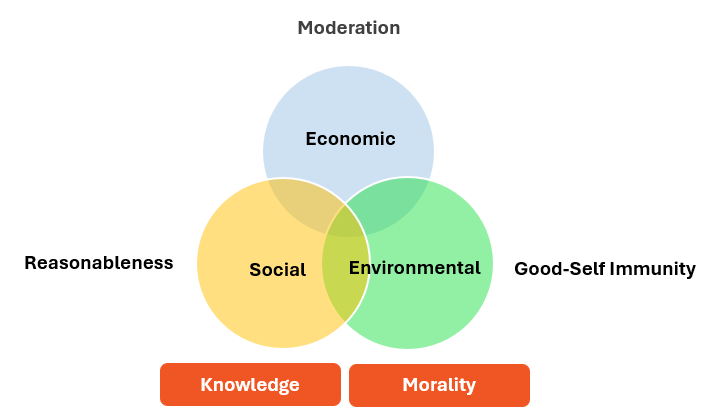
Sustainability Development Policy
Sustainable Development Framework
The Board of Directors has established a framework for sustainable development to be used as an operational guideline to create sustainability for the organization in a balance of economic, social and environmental dimensions, focusing on business and performance growth based on social responsibility through creating added value for the quality of life and well-being of employees, communities, and society, placing importance on environmental care and the wise use of energy and resources, promoting good corporate governance by conducting business with morality and ethics, honesty, transparency, and accountability, strictly complying with laws and regulations, and effectively managing risks. This is to ensure peaceful and quality coexistence in society, create sustainable value for all stakeholders, and respond to the Sustainable Development Goals (SDGs) of the United Nations.

Efficient governance and management is key factors to drive the organization toward sustainability and support business growth and long term success.
To drive sustainable development strategies, goals and operations across the organization, the Board of Directors has established sustainable development governance structure that has engaged everyone, from the Board of Directors, sub-committee, executives at all levels and all employees.
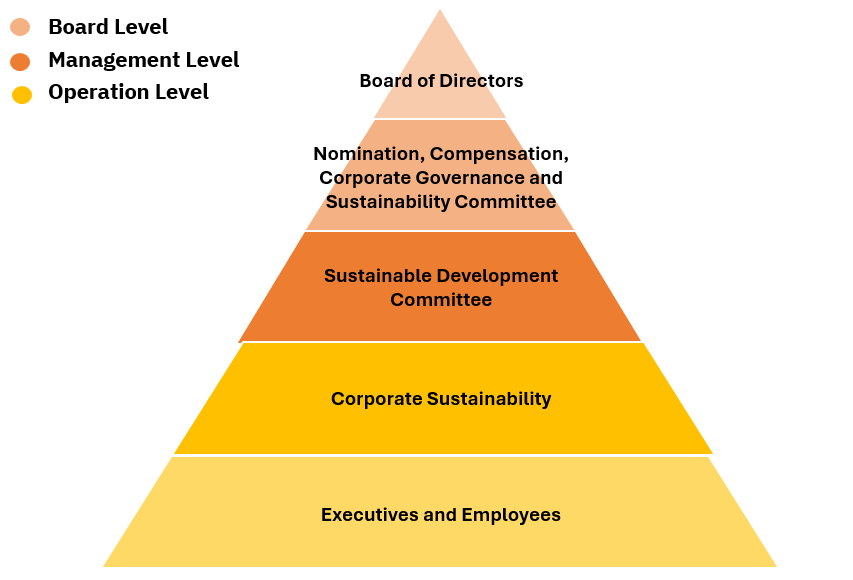
| Board of Directors | Nomination, Compensation, Corporate Governance and Sustainability Committee | Sustainable Development Committee
consists of the president, C-Suite executives and executives at the level of division head, business unit head, and department head |
| has duties to: | has duties to: | has duties to: |
| · Define vision, mission, values, objectives, goals, and directions for operating business.
· Approve sustainable development policy, practices and framework, covering environmental, social, economic and governance dimensions, including ESG materiality. · Oversee to ensure that the establishment of an organizational structure is conducive to good corporate governance and effective drive of sustainable development operations. · Ensure strategic integration of sustainable development and business. |
· Consider and scrutinize sustainable development policy, practices, strategies and frameworks, including prioritization of ESG topics.
· Provide advisory and recommendation on the preparation of sustainable development plans, including setting metrics and goals. · Oversee and monitor performance of sustainable development. · Oversee to ensure that reporting and information disclosure about sustainable development performance comply with regulations, requirements and standards. · Provide advisory and recommendations to ensure that sustainable development operations can achieve the set goals. |
· Outline and review the sustainable development policy and practices, covering environmental, social, economic and governance dimensions.
· Define goals, strategies, frameworks, management approaches, and indicators of sustainable development. · Evaluate and prioritize ESG topics. · Report on the sustainable development performance to the Nomination, Compensation, Corporate Governance and Sustainability Committee and the Board of Directors on a regular basis. · Disclose information about sustainable development to public. |
| Corporate Sustainability | Executives and Employees |
| has duties to: | has duties to: |
| · Refine action plans to ensure implementation of policy and strategies of sustainable development.
|
acknowledge, study and understand the sustainable development policy and related practices; as well as support, promote, drive, and comply with the established policies and action plans. |
| · Coordinate with all divisions within the organization to communicate, provide guidance, build understanding, awareness and engagement with executives and employees to ensure that they perform duties in accordance with the sustainable development policy, framework, practical guidelines and action plans. | |
| · Monitor and measure performance of all divisions to ensure achievement of sustainable development goals. | |
| · Prepare and present report on sustainable development performance to the Sustainable Development Committee on a monthly basis. | |
Symphony Communication Public Company Limited is committed to working with stakeholders throughout the business value chain and maintaining good relationships in the long term, taking into account sustainability factors in order to meet the expectations of all stakeholders.
Business Value Chain
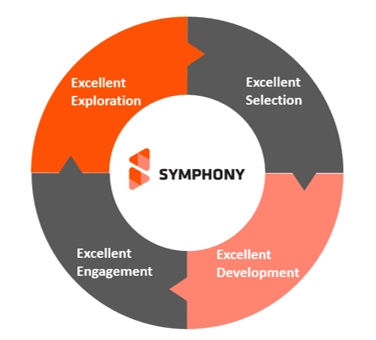
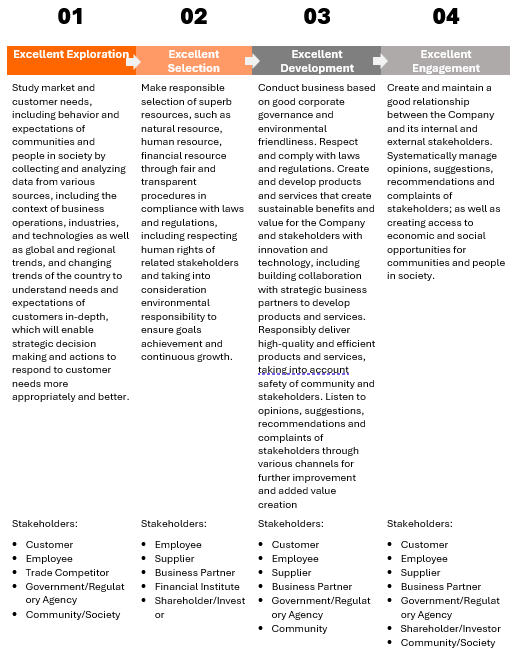
Stakeholder Engagement
The Company has established a stakeholder engagement policy and practical guidelines to systematically promote stakeholder engagement and has continuously reviewed its stakeholder engagement operations to find ways to efficiently and appropriately respond to expectations and issues arisen by stakeholders. The Company classifies stakeholders into nine (9) groups, taking into consideration their relation to the Company’s business, impacts from the Company’s business operations towards stakeholders, and sustainability impacts from stakeholders towards the Company, and prioritize stakeholders based on the level of impact on the stakeholders from the Company’s operations in the areas of economy, society, environment, and human rights, together with their level of impact or influence on the Company as follows: 1) employees, 2) customers, 3) suppliers, 4) business partners, 5) government and regulatory agencies, 6) creditors (financial institutes), 7) community and society, 8) shareholders and investors, and 9) trade competitors.
Implementations with Stakeholders
Employees
Communication/ Engagement Channels
- Internal communication through various channels
- Annual employee engagement survey
- Townhall meeting
- Company activities
- Communication channels between the Company and employees, e.g., website, social media, etc.
- Complaint and whistleblowing channel
Interests/Expectation
- Good, appropriate and fair compensation and benefits
- Career advancement and stability
- Support for potential and knowledge development
- Effective and fair performance appraisal system
- Caring for the quality of life and well-being of employees, including a good, hygienic and safe working environment
- Work-life balance and happiness at work
- Respect for rights and equitable treatment
- Participation in expressing opinions
- Retaining employees who are potential
Company’s responses
- Establish company policies and procedures in accordance with relevant laws.
- Respect human rights and strictly comply with human rights policy.
- Treat all employees equitably and fairly.
- Respect employees’ privacy rights.
- Promote career advancement and provide appropriate compensation and benefits.
- Promote continuous development of potential, knowledge and skills for employees.
- Promote work safety by providing a clean and safe working environment.
- Promote good work behavior and promote diversity and acceptance of differences among employees.
- Organize recreational activities, including activities to build good relationships among employees and their engagement to the organization.
- Conduct annual employee engagement surveys and performance evaluations.
- Provide secure channels for expressing opinions and making complaints.
- Organize social and environmental projects to promote a sense of social and environmental responsibility.
Customers
Communication/ Engagement Channels
- Meeting and visiting customers
- Services center and call center
- Customer relations activities and marketing activities
- Customer satisfaction and engagement survey
- Complaint channels and various communication channels, such as website, email, telephone, letter, social media, etc.
- Perspective survey on expectations of customer representatives as part of the preparation or improvement of the company’s action plan
Interests/Expectation
- Coverage area
- Quality, efficiency and stability of network
- A variety of services that meet needs and enhance business efficiency and competitiveness
- Exclusive services and tailored experience
- Appropriate and fair price
- Provision of service information with knowledge and expertise in a responsible way
- Delivery of quality products and services according to standards, in line with expectations, and in accordance with terms and conditions and relevant laws.
- Reliability, confidence, flexibility and proper adjustment
- After sales service, prompt responsiveness to problems or complaints and attentiveness to resolve problems in a timely manner
- Various and easily accessible communication channels
- Data security and customer privacy/confidentiality protection
- Ongoing and sustainable services
Company’s responses
- Continuously develop, expand and improve network quality and equipment with cutting-edge, safe, and environmental-friendly technology.
- Develop and deliver solutions and digital services that can meet customer needs.
- Deliver excellent experiences and services that exceed expectations before, during and after service by a knowledgeable, capable and experienced team.
- Regularly conduct customers’ opinions and satisfaction surveys.
- Study customer needs and listen to their opinions, expectations, concerns and impacts, and use them to improve and develop services consistently.
- Provide training to employees to provide excellent customer service
- Provide various contact and communication channels, such as telephone, email, service center, website, social media, etc.
- Strengthen confidence in information security management with ISO/IEC 27001:2013
Suppliers
Communication/ Engagement Channels
- Seminar and meeting with supplier
- Complaint channels and communication channels between the Company and suppliers/vendors, e.g., website, phone, e-mail, social media
- Perspective survey on expectation of representatives of suppliers and contractors as part of the preparation or improvement of the company’s action plan
- Supplier relations activities, such as CSR activities
Interests/Expectation
- Fair and equitable treatment
- Fair and transparent procurement process
- Clear procurement policy
- Adherence to the established agreement
- Flexibility to adjust prices of products or services
- Long-term relationship
- Support and development for mutual growth
Company’s responses
- Establish transparent and fair procurement process; regularly review and improve procurement process and communication to meet mutual needs
- Share knowledge and technologies to improve procurement process
- Review and take immediate action on any issues that occurred
- Do not request or receive any dishonest benefits, whether directly or indirectly.
Business Partners
Communication/ Engagement Channels
- Memorandum of Understanding of joint business operations
- Business dialogues
- Meetings, events, and activities
- Various communication channels, such as websites, email, telephone, social media, etc.
- Perspective survey on expectations of partner representatives as part of the preparation or improvement of the company’s action plan
Interests/Expectation
- Creation of shared value and mutual business benefits
- Enhancement of business competitiveness
- Knowledge sharing for business improvements and innovation in new products and services development
- Willingness to provide support promptly when issues occur
- Business integrity and transparency
- Business continuity
- Trust, good relationships, and cooperation to achieve higher potential and efficiency that benefit long-term business deals
Company’s responses
- Review and discuss with business partners on value-creation initiatives
- Provide teams to collaboratively work with partners to improve business processes and benefits
- Practice effective communication.
- Review and take immediate action on any issues that occurred.
Government/Regulatory Agencies
Communication/ Engagement Channels
- Occasional visit
- Meetings or seminars for exchanging ideas
- Initiatives and activities of government/regulatory agencies
- Various communication channels, such as websites, telephone, email, letter, social media, etc.
Interests/Expectation
- Compliance with laws, rules, regulations and good corporate governance principles
- Disclosure of information with accuracy, completeness and transparency
- Collaboration and support for activities organized by government/regulatory agencies
- Business operation with responsibility towards the community, society and the environment.
Company’s responses
- Strictly comply with applicable laws and regulations.
- Operate business with integrity and transparency based on good corporate governance principles.
- Disclose information or prepare a report in accordance with the criteria stipulated by regulatory agencies.
- Support and participate in activities and programs organized by government agencies.
- Conduct business with responsibility towards community, society and environment.
Creditors (Financial Institutes)
Communication/ Engagement Channels
- Meeting with relevant executives and employees
- Various communication channels, such as email, telephone, letters, website, social media, etc.
Interests/Expectation
- Compliance with agreed terms, conditions and obligations
- On-time repayment
- Good liquidity management
- Financial stability, debt repayment ability
- Business continuity and performance growth
- Transparent business operation
Company’s responses
- Pay debt on time.
- Abide by established terms and conditions.
- Provide accurate and complete information.
Community and Society
Communication/ Engagement Channels
- Activities with the community
- Community engagement through employment
- Channels for receiving complaints and various communication channels, such as website, email, telephone, letter, social media, etc.
Interests/Expectation
- Business operation with responsibility toward community, society, and environment
- Safety
- Job opportunities and income
- Cooperation and support for community activities
- Arrangement of activities that are beneficial for community, society and environment
- Application of the Company’s knowledge, skills, and expertise to develop community
- Participation in economic and social development
Company’s responses
- Strictly comply with applicable laws and regulations
- Oversee the network equipment installation process to ensure that all parties involved carry out their work in accordance with the procedures and that there is no negative impact on the communities.
- Assess the impact on business operations that may affect the community, society and environment.
- Study, learn, understand, listen to community feedback and respond to expectations.
- Promote local employment
- Respect local tradition and culture
- Provide support and participate in activities arranged by communities, or activities that are beneficial for society and the public.
- Build awareness and promote corporate culture of social and environmental responsibility.
Shareholders / Investors
Communication/ Engagement Channels
- Shareholders’ meeting
- Various communication channels, such as Company’s website, SET website, email, telephone, letters, etc.
- Investor Relations events and activities, such as opportunity day, analyst meeting, quarterly meeting with analyst and investors
- Annual Registration Statement/Annual Report (Form 56-1 One Report)
- Perspective survey and interview on expectations of shareholders representatives
Interests/Expectation
- Business continuity and performance growth
- Stability of income and cash flow
- Regular dividend payment
- Respect for shareholders’ rights and equitable treatment
- Good corporate governance, transparency, and social and environmental responsibilities
- Efficient risk and crisis management
- Disclosure of financial and non-financial information accurately, completely and in a timely manner through various and easily accessible channels
- Effective communication
- Opportunity to express opinion on business performance
- Innovation to enhance business efficiency
Company’s responses
- Create constant business growth
- Pay dividends where possible
- Operate in accordance with good corporate governance principles, be social responsibility, and preserve environment
- Establish and continuously update good corporate governance policy and related practices
- Disclose important information accurately, in a timely manner, and in accordance with the requirements of the regulatory agencies
- Cleary and continuously communicate with shareholders and investors
Trade Competitors
Communication/ Engagement Channels
- Meeting arranged by industry associations or organizations
- Collaboration projects at the request of the relevant government or regulatory agencies
Interests/Expectation
- Legal and fair competition
Company’s responses
- Conduct business with ethics.
- Strictly comply with the Business Code of Business regarding the treatment of trade competitors.
- Provide collaboration in activities.
Symphony Communication Public Company Limited attaches importance to the management of both internal and external sustainability issues and has thus instituted a materiality assessment and prioritization process in compliance with the Standards of the Global Reporting Initiative (GRI).
The Company compiles and assesses issues related to sustainable development through materiality assessment, which places emphasis on the context of sustainability, global and regional trends, and direction in the telecommunication industry, while taking into account the Company’s operational strategies and risk factors both at present and in the future that may provide impacts or create opportunities for the Company’s business operations.
Materiality Assessment Process
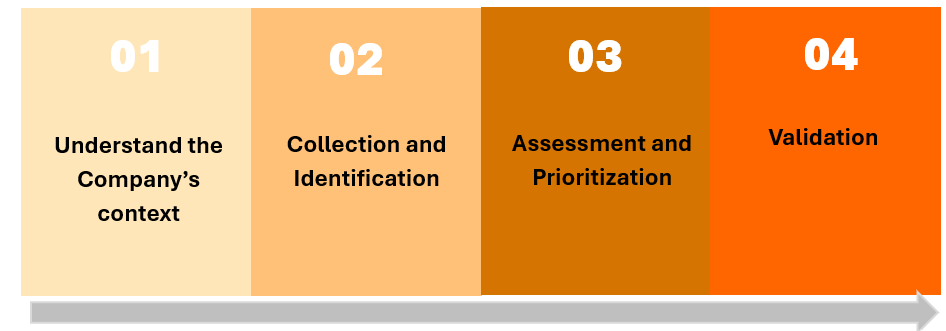
- Understanding the Company’s context
Study and analyze the Company’s sustainability context by considering both internal and external factors, as well as global and regional trends. This includes assessing sustainability trends and directions, key industry-specific issues, sustainability standards and industry assessment criteria, and global concerns.
- Collection and Identification
Gather sustainability issues by analyzing perspectives, expectations, interests, and concerns and key topics raised by all stakeholders’ groups, both internal and external, across the entire value chain. This process also considers changes in global and industry trends, historical events, current and future risk factors that may pose challenges or opportunities for business operations, and human rights principles. Then, identify sustainability topics that impact on the Company’s sustainability, both positively and negatively, and categorize them into environmental, social, and economic & corporate governance topics.
- Assessment and Prioritization
Incorporated the identified sustainability topics into the materiality assessment and prioritization process, applying the Double Materiality and Multi-stakeholder Approach, to provide a comprehensive view of the impact on business operations, both financial and non-financial, on stakeholders, including society and environment (Outward Impact) and the impact on the Company’s business operations (Inward Impact). The assessment process involves interviews and online surveys for external stakeholders, selected through purposive sampling, and online surveys for internal stakeholders. Data collected from stakeholders is analyzed using scoring criteria that assess the level of severity and likelihood of impacts on the Company and its stakeholders. A Materiality Matrix is then developed to present the importance of each sustainability topic, where the Y-axis represents the importance level of environmental, social, and governance (ESG) issues on stakeholders, and the X-axis represents the important level of ESG issues on the Company’s business operations. The Company categorizes the material sustainability topics into three levels of their importance as follows:
- Very critical topic refers to a topic with a critical impact on the Company’s sustainability and strategic goals.
- Moderately critical topic refers to a topic that requires manageable actions but are not of the critical impact and highest priority.
- Less critical topic refers to a topic with limited impact that can be managed and addressed easily.
- Validation
Present the assessment results and prioritization of material sustainability topics to the Chief Executive Officer for review. This ensures that the material topics are aligned with the Company’s context, strategy, objectives and goals before formulating sustainability strategies and management approaches across different dimensions. Following this review, relevant departments are assigned to implement actions in response to material sustainability topics.
The Nomination, Compensation, Corporate Governance and Sustainability Committee is responsible for and reviewing and approving the Company’s material sustainability topics, strategies, and management approaches before presenting them to the Board of Directors for final approval.
Materiality Assessment and Prioritization
In 2024, the Company conducted a review of its material topics based on the material topics identified in 2023, in reference to the GRI Universal Standards, taking into consideration the Double Materiality and Multi-stakeholder Approach. This approach provides a comprehensive view of both the negative and positive impacts of the Company’s business operations on the economy, society, environment, and stakeholders (Outward Impact) and the financial and value-creation impacts on the Company (Inward Impact). Additionally, the Company has conducted a comprehensive review of human rights impacts on stakeholders, whether they have already occurred or may arise in the future, scanning across the organization’s activities and business relationships throughout the value chain, such as those with its suppliers.
In 2024, the Company retained the same 20 material sustainability topics as in 2023. These topics were assessed and classified into three levels based on their importance to stakeholders and the Company across environmental, social, economic, and corporate governance dimensions, consisting of five very critical topics, five moderately critical topics, and 10 less critical topics. Since all the material topics were inherently linked to human rights of stakeholders, human rights issue was not listed as a separate topic. Instead, the Company conducted human rights due diligence and implemented risk management measures for each topic to minimize both the likelihood and impact on stakeholders.
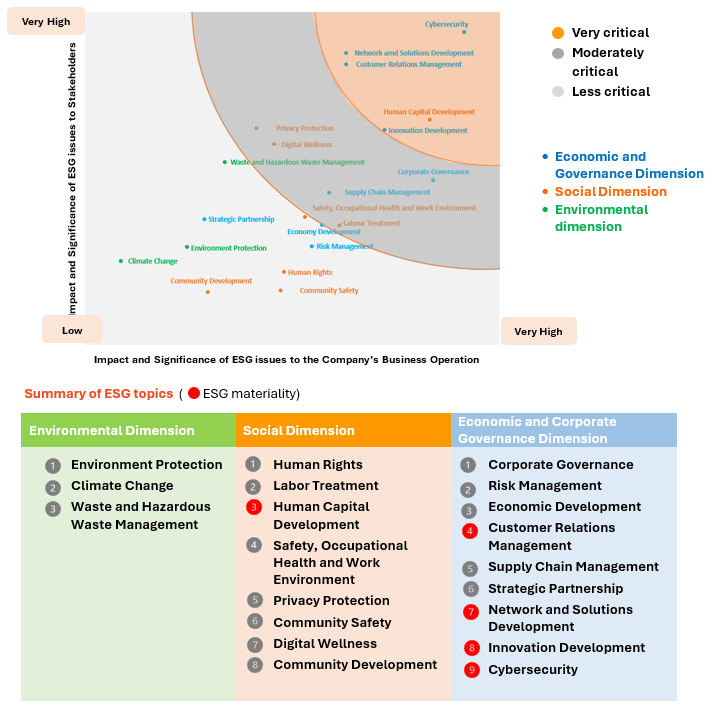
The Company’s sustainability goals and strategies are driven by its commitment to the pledge “Excellent Experience for ALL,” which reflects the Company’s dedication to creating value for both the business and all stakeholders across the value chain. This commitment is rooted in a strong sense of social responsibility, with a focus on creating opportunities and advancing initiatives that improve people’s quality of life. At the same time, the Company strives to operate as an environmentally responsible organization, contributing to a sustainable future for the planet. Accordingly, the Company has established its sustainability strategy by integrating technology and innovation into its sustainability management framework, ensuring a comprehensive approach that encompasses all dimensions—environmental, social, economic, and corporate governance.
เป้าหมาย กลยุทธ์และแนวทางการบริหารจัดการด้านความยั่งยืน_EN
| Sustainability Development Framework | Commitment | Goals | Strategies and Management Approaches | Contribution to UNSDGs |
| Economic and Corporate Governance Dimension | To be an organization that drives sustainable growth for all stakeholders across the value chain, while actively supporting the development and advancement of Thailand’s digital economy and society through a strong and intelligent telecommunications infrastructure. |
• Revenue and operating profit demonstrate consistent and continuous growth. • Intelligent network infrastructure covers key economic areas throughout the country. • Products and services are designed to meet the full spectrum of customer needs. • Annual overall customer satisfaction score reaches 95% • 100% of business partners acknowledge and comply with the Supplier Code of Conduct. • Ability to consistently maintain an “Excellent” or “5-Star” rating in corporate governance assessments every year. • Success in continuously being certified as a member of the Thai Private Sector Collective Action against Corruption (CAC). |
• Conduct business in a transparent, auditable, and responsible manner under the good corporate governance principles. • Follow business ethics and oppose all forms of corruption. • Manage risks effectively according to international standards. • Find funding sources and manage finances carefully. • Invest in enhancing network efficiency with innovation and cutting-edge technology. • Invest in expanding network to cover all areas to create economic growth. • Promote innovation development to enhance products and services, service quality and operational efficiency. • Deliver services to customers in a responsible manner. • Consistently manage customer relationships and satisfaction. • Promote collaboration with strategic partners to expand new business opportunities and to deliver a diverse range of solutions suiting customers’ needs. • Build relationships with suppliers and business partners to create sustainable mutual benefits for all parties. • Maintain resiliency for data security and cyber security. • Integrate sustainable development into its operational activities. |
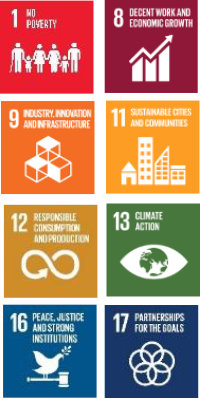 |
| Social Dimension | To be a socially responsible corporate citizen committed to creating sustainable value for all segments of society. |
• Employee engagement score of not less than 85% • Decrease of employee turnover rate. • Zero work accident • 100% of people in society can access basic services, information and technologies |
• Respect human rights and labor rights. • Treat labor fairly, in conformity to and beyond labor standards, regulations, and laws. • Promote diversity and equitable treatment of each other regardless of any differences. • Manage human resources efficiently. • Enhance human capital capacity by supporting training and necessary resources. • Promote wellbeing of employees. • Promote good management system of occupational health, safety and working environment. • Protect personal data and privacy of all groups of stakeholders. • Invest in expanding network coverage to provide inclusive digital access to basic services and information to promote social wellbeing. • Support and promote employees, including business partners and suppliers to have awareness of social responsibility. • Promote the Company’s engagement with communities and related stakeholders to build relationship, create understanding and strong cooperation. |
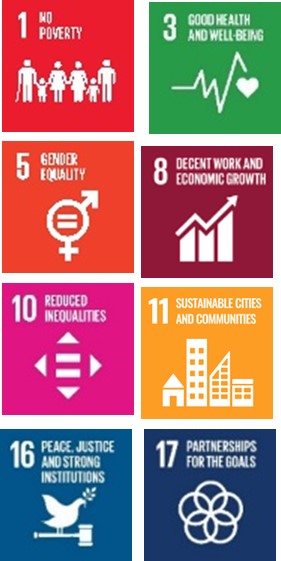 |
| Environmental Dimension | To be an environmentally responsible corporate citizen in all aspects of its operations. |
• Reduce consumption of electricity and fuel energy from operations. • Reduce paper used in the office. • Reduce amount of waste from business operation. • Reduce greenhouse gas emissions intensity to meet Net Zero target in 2050. |
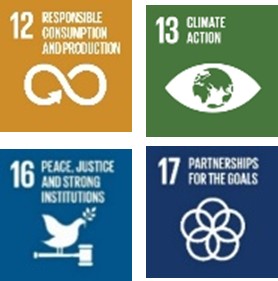 |


